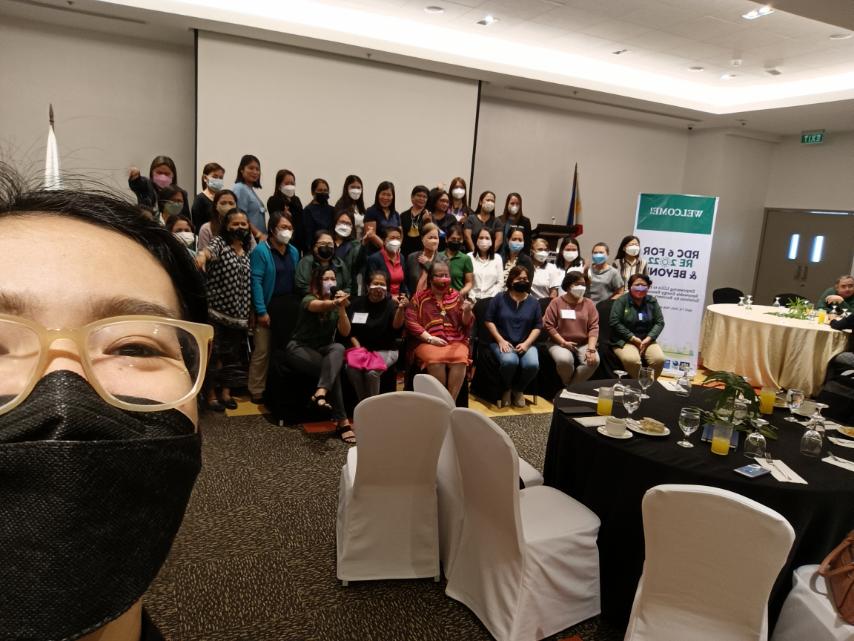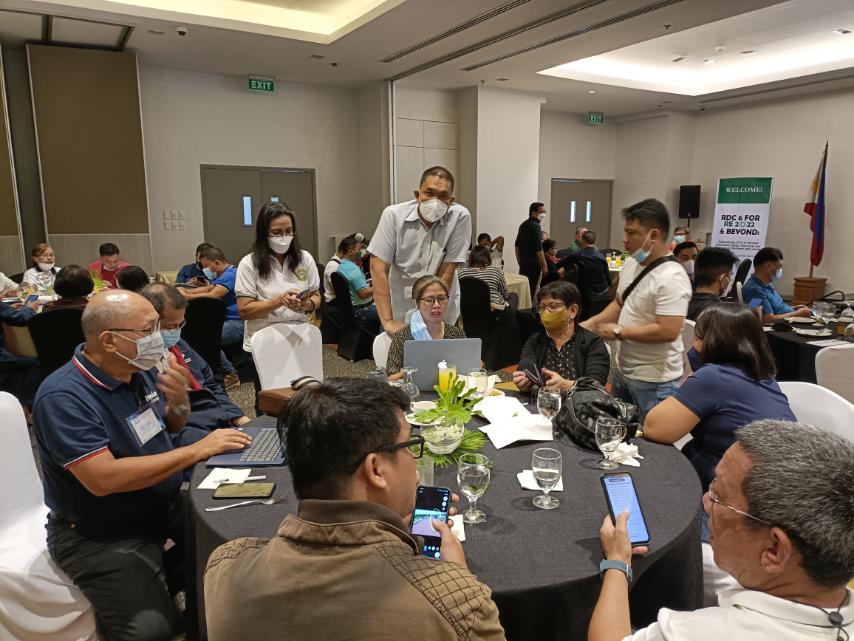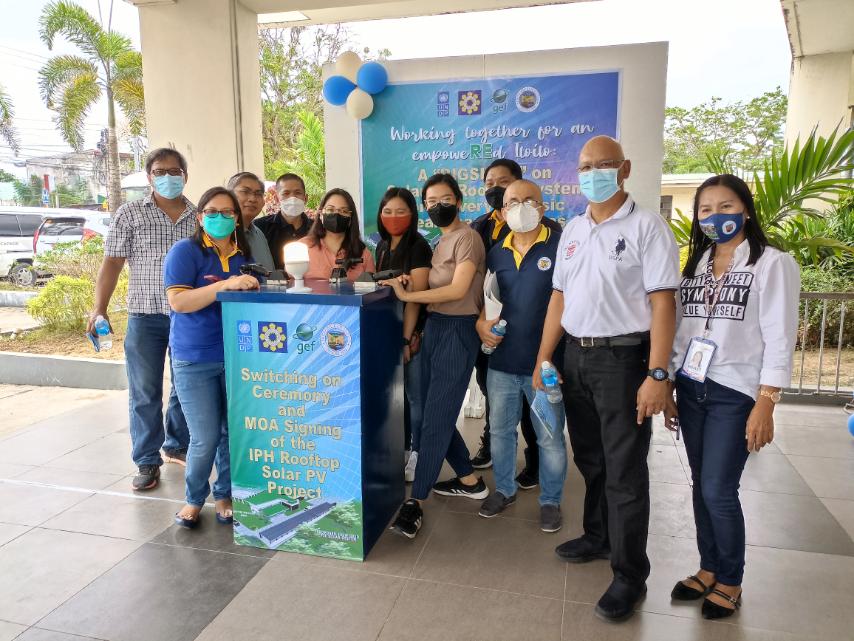By Tea Jalin Ty, Monitoring and Evaluation Officer & Louise Manalo, Research Assistant, UNDP DREAMS Project
Regions Empowered for Renewable Energy: Reflections from Western Visayas
September 28, 2022

Local RE Champions include Women: women engineers, LGU staff, and other participants in attendance with UNDP DREAMS female staff taking a selfie in celebration of women working on RE.
Sustainable Development Goal 7 envisions access to affordable, clean energy for all. For the Philippines, among the paths towards this SDG is the National RE Program 2020-2040, which outlines the roadmap towards a 35% renewable energy share of the country’s power generation mix by 2030. These goals are global and national in scale and ambition, and yet among its most vital movers and champions are in the regions, provinces, and communities.
We met such champions in Western Visayas during the Regional Development Council VI (RDC VI) for Renewable Energy (RE) 2022 and Beyond: Empowering Local Government Units (LGUs) to Harness Renewable Energy Resources and Solutions for Recovery and Growth Conference Workshop* The event was held last 7-8 April 2022 at Park Inn by Radisson Iloilo and online via Zoom and Facebook Live.
The gathering of 187 participants from Western Visayas electric cooperatives/ distribution utilities, local government units, RDC VI executives, private sector, renewable energy suppliers/ providers, research institutions and national government agencies proved that local level champions had a vital role in understanding and achieving our global and national goals. We share three reflections here.
Inter-Agency Alignment and Cooperation for RE
With the numerous entities with their own mandates and constraints involved in local RE development, lack of alignment are barriers, and sometimes dead ends, to local RE development. Platforms to make alignment happen may be vital.
Developing generation facilities involve regulators and public institutions aside from the DOE. For one, the Department of Environment and Natural Resources (DENR) require permits and environmental impact assessments, especially projects and RE resources near or in protected areas. Many LGUs shared challenges in pursuing RE projects that have difficulty securing appropriate DENR permits, despite RE’s benefits to their locality’s environment and economic development.
The National Irrigation Administration (NIA), which develops irrigation systems, may also be involved in developing LGU micro-hydro projects. There is high interest for hydro projects with irrigation components among Region 6 LGUs, but there is uncertainty on NIA’s role in the development, operations, and management if said irrigation component.
There is also Distribution Utilities (DUs). Recognized for its role in transmission, DUs are also vital in RE generation development. Many DUs have or want to pursue their own RE generation facilities. However, Central Negros Electric Cooperative (CENECO) lamented the challenge of financing capital expenditures. They share that electric cooperatives (ECs) do not integrate such costs in tariff structures. CENECO has also been perceived as risky to investors as EC franchises may end well before RE facilities’ decade-long lifespans and equally long-term power supply agreements.
Capacity Building for LGUs
Having policies for decentralization to local governments may not necessarily translate to local renewable energy development. LGUs are eager to take on the challenge but wonder how to start. Many of LGUs who participated in the workshop do not have an energy sector code and have indicated a lack of knowledge regarding energy sector policies as the main reason. Only two LGUs among those present have issued an ordinance adopting the guidelines to facilitate the implementation of energy projects.

LGU staff brainstorm to identify the capacity and institutional challenges they encounter in mainstreaming RE
The participants also noted a general lack of knowledge of renewable energy sources and technologies; which in turn, constraining rapid adoption. The LGUs were interested in learning about the different systems, while sharing their concerns over the planning, cost, financing, operation, and maintenance of RE projects.
The event’s breakout sessions on introductions to different RE technologies were a start. Its lively open Q&A fora showed the work ahead for deeper technical capacities to plan, build, operate, and sustain RE projects.
RE - More Than Just Electrification
Lastly, while RE indeed plays a role in electrification solutions, framing it in such isolation may lead to missing RE’s social welfare and livelihood outcomes. RE development is often framed as infrastructure for community electricity supply. LGUs and regulators also tend to see RE in this lens, zooming in on issues like RE feasibility studies and funding for RE investments. In LGUs, RE is sometimes tucked under infrastructure committees of local development councils.
RE projects in Region 6 designed with wider social applications in mind may be models of a better practice. An example MHP project was introduced by Engineer Melvin Purzuelo, DREAMS Project Consultant during the conference. Engineer Purzuelo showcased the proposed rehabilitation of an MHP in San Remigio, Antique, which included irrigation and livelihood components alongside electrification. The San Remigio MHP rehabilitation will receive support from the Support Facility for Renewable Energy (SF4RE) under the DREAMS project.

Iloilo, RE Champion: Staff of the Iloilo Provincial Government Health Management Office, Provincial Development Office, Iloilo Provincial Hospital (IPH), UNDP DREAMS Consultants and Project Staff at the Memorandum of Agreement Signing for the 75 MW Solar PV Rooftop for the IPH held aptly a day before the RDC VI RE Conference, on April 6, 2022 at the IPH Main Building, Pototan, Iloilo.
Another example can be seen in Iloilo, where the Iloilo Provincial Hospital is installing a rooftop solar PV system. Proposed by the Iloilo Provincial Government, and supported through the UNDP DREAMS SF4RE, The RE facility hopes to provide reliable, clean energy to the ICU, emergency room, and molecular lab, and ultimately, to the province’s fight against the pandemic.
LGUs understanding RE as socio-economic solutions would ensure that potential may be captured even from project design stage. This is especially crucial as field assessments and data for electrification may be also used to assess potential for water security and irrigation.
A more holistic framing of RE could prove more compelling and incentivize faster adoption among LGUs. RE could be reframed as an enabler for multiple socio-economic mandates. These socio-economic mandates are familiar to LGUs, and often perceived as more immediate. Rather than being yet another overtly technical and capital-intensive matter for compliance, RE may be seen as a part of the local government’s existing work for their community’s sustainable development. [E]
*The two-day RDC VI for RE 2022 and Beyond was initiated through the RDC VI Resolution No. 28 Series of 2021 requesting for a webinar to power LGUs for RE, and the efforts of Green Forum Western Visayas. The event was supported by the Department of Energy (DOE), Global Environment Facility and the United Nations Development Programme (UNDP) through the Development for RE Applications Mainstreaming and Market Sustainability (DREAMS) Project. Event partners also include the Department of Interior and Local Government (DILG), and National Economic and Development Authority (NEDA) VI.
--------
ABOUT THE DREAMS PROJECT
Development for Renewable Energy Applications Mainstreaming and Market Sustainability (DREAMS) is a June 2016 – January 2023 project being implemented by the Department of Energy through the Renewable Energy Management Bureau, in partnership with the United Nations Development Programme and the Global Environment Facility. The project will promote and facilitate the commercialization of renewable energy markets through the removal of barriers that will increase investments in RE-based power generation projects.
Support Facility for RE (SF4RE) is a $1.7 million facility under the Development for Renewable Energy Applications Mainstreaming and Market Sustainability (DREAMS) project which aims to provide local capacities and encourage investments that will integrate RE policies and projects in the executive and legislative agenda of LGUs, DUs, academe and the community strategies of other agencies organizations, rural electric cooperatives, and civil society organizations/foundations. Off-grid and far-flung areas are priority sites.

 Locations
Locations



